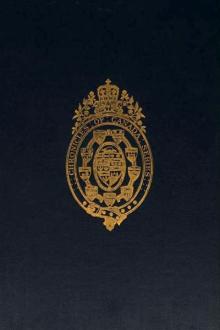The Dawn of Canadian History by Stephen Leacock (each kindness read aloud .TXT) 📕

- Author: Stephen Leacock
- Performer: -
Book online «The Dawn of Canadian History by Stephen Leacock (each kindness read aloud .TXT) 📕». Author Stephen Leacock
Leif and his men sailed away, and soon they discovered another land. The chronicle does not say how many days they were at sea, so that we cannot judge of the distance of this new country from the Land of Stones. But evidently it was entirely different in aspect, and was situated in a warmer climate. The coast was low, there were broad beaches of white sand, and behind the beaches rose thick forests spreading over the country. Again the Norsemen landed. Because of the trees, they gave to this place the name of Markland, or the Country of Forests. Some writers have thought that Markland must have been Newfoundland, but the description also suggests Cape Breton or Nova Scotia. The coast of Newfoundland is, indeed, for the most part, bold, rugged, and inhospitable.
Leif put to sea once more. For two days the wind was from the north-east. Then again they reached land. This new region was the famous country which the Norsemen called Vineland, and of which every schoolboy has read. There has been so much dispute as to whether Vineland—this warm country where grapes grew wild—was Nova Scotia or New England, or some other region, that it is worth while to read the account of the Norse saga, literally translated:
They came to an island, which lay on the north side of the land, where they disembarked to wait for good weather. There was dew upon the grass; and having accidentally got some of the dew upon their hands and put it to their mouths, they thought that they had never tasted anything so sweet. Then they went on board and sailed into a sound that was between the island and a point that went out northwards from the land, and sailed westward past the point. There was very shallow water and ebb tide, so that their ship lay dry; and there was a long way between their ship and the water. They were so desirous to get to the land that they would not wait till their ship floated, but ran to the land, to a place where a river comes out of a lake. As soon as their ship was afloat they took the boats, rowed to the ship, towed her up the river, and from thence into the lake, where they cast anchor, carried their beds out of the ship, and set up their tents.
They resolved to put things in order for wintering there, and they erected a large house. They did not want for salmon, in both the river and the lake; and they thought the salmon larger than any they had ever seen before. The country appeared to them to be of so good a kind that it would not be necessary to gather fodder for the cattle for winter. There was no frost in winter, and the grass was not much withered. Day and night were more equal than in Greenland and Iceland.
The chronicle goes on to tell how Leif and his men spent the winter in this place. They explored the country round their encampment. They found beautiful trees, trees big enough for use in building houses, something vastly important to men from Greenland, where no trees grow. Delighted with this, Leif and his men cut down some trees and loaded their ship with the timber. One day a sailor, whose home had been in a 'south country,' where he had seen wine made from grapes, and who was nicknamed the 'Turk,' found on the coast vines with grapes, growing wild. He brought his companions to the spot, and they gathered grapes sufficient to fill their ship's boat. It was on this account that Leif called the country 'Vineland.' They found patches of supposed corn which grew wild like the grapes and reseeded itself from year to year. It is striking that the Norse chronicle should name these simple things. Had it been a work of fancy, probably we should have heard, as in the Chinese legends, of strange demons and other amazing creatures. But we hear instead of the beautiful forest extending to the shore, the mountains in the background, the tangled vines, and the bright patches of wild grain of some kind ripening in the open glades-the very things which caught the eye of Cartier when, five centuries later, he first ascended the St Lawrence.
Where Vineland was we cannot tell. If the men really found wild grapes, and not some kind of cranberry, Vineland must have been in the region where grapes will grow. The vine grows as far north as Prince Edward Island and Cape Breton, and, of course, is found in plenty on the coasts of Nova Scotia and New England. The chronicle says that the winter days were longer in Vineland than in Greenland, and names the exact length of the shortest day. Unfortunately, however, the Norsemen had no accurate system for measuring time; otherwise the length of the shortest winter day would enable us to know at what exact spot Leif's settlement was made.
Leif and his men stayed in Vineland all winter, and sailed home to Greenland in the spring (1001 A.D.). As they brought timber, much prized in the Greenland settlement, their voyage caused a great deal of talk. Naturally others wished to rival Leif. In the next few years several voyages to Vineland are briefly chronicled in the sagas.
First of all, Thorwald, Leif's brother, borrowed his ship, sailed away to Vineland with thirty men, and spent two winters there. During his first summer in Vineland, Thorwald sent some men in a boat westward along the coast. They found a beautiful country with thick woods reaching to the shore, and great stretches of white sand. They found a kind of barn made of wood, and were startled by this first indication of the presence of man. Thorwald had, indeed, startling adventures. In a great storm his ship was wrecked on the coast, and he and his men had to rebuild it. He selected for a settlement a point of land thickly covered with forest. Before the men had built their houses they fell in with some savages, whom they made prisoners. These savages had bows and arrows, and used what the Norsemen called 'skin boats.' One of the savages escaped and roused his tribe, and presently a great flock of canoes came out of a large bay, surrounded the Viking ship, and discharged a cloud of arrows. The Norsemen beat off the savages, but in the fight Thorwald received a mortal wound. As he lay dying he told his men to bury him there in Vineland, on the point where he had meant to build his home. This was done. Thorwald's men remained there for the winter. In the spring they returned to Greenland, with the sad news for Leif of his brother's death.
Other voyages followed. A certain Thorfinn Karlsevne even tried to found a permanent colony in Vineland. In the spring of 1007, he took there a hundred and sixty men, some women, and many cattle. He and his people remained in Vineland for nearly four years. They traded with the savages, giving them cloth and trinkets for furs. Karlsevne's wife gave birth there to a son, who was christened Snorre, and who was perhaps the first white child born in America. The Vineland colony seems to have prospered well enough, but unfortunately quarrels broke out between the Norsemen and the savages, and so many of Karlsevne's people were killed that the remainder were glad to sail back to Greenland.
The Norse chronicles contain a further story of how one of Karlsevne's companions, Thorward, and his wife Freydis, who was a daughter of Eric the Red, made a voyage to Vineland. This expedition ended in tragedy. One night the Norsemen quarrelled in their winter quarters, there was a tumult and a massacre. Freydis herself killed five women with an axe, and the little colony was drenched in blood. The survivors returned to Greenland, but were shunned by all from that hour.
After this story we have no detailed accounts of voyages to Vineland. There are, however, references to it in Icelandic literature. There does not seem any ground to believe that the Norsemen succeeded in planting a lasting colony in Vineland. Some people have tried to claim that certain ancient ruins on the New England coast—an old stone mill at Newport, and so on—are evidences of such a settlement. But the claim has no sufficient proof behind it.
On the whole, however, there seems every ground to conclude that again and again the Norsemen landed on the Atlantic coast of America. We do not know where they made their winter quarters, nor does this matter. Very likely there were temporary settlements in both 'Markland,' with its thick woods bordering on the sea, and in other less promising regions. It should be added that some writers of authority refuse even to admit that the Norsemen reached America. Others, like Nansen, the famous Arctic explorer, while admitting the probability of the voyages, believe that the sagas are merely a sort of folklore, such as may be found in the primitive literature of all nations. On the other hand, John Fiske, the American historian, who devoted much patient study to the question, was convinced that what is now the Canadian coast, with, probably, part of New England too, was discovered, visited, and thoroughly well known by the Norse inhabitants of Greenland. For several centuries they appear to have made summer voyages to and from this 'Vineland the Good' as they called it, and to have brought back timber and supplies not found in their own inhospitable country. It is quite possible that further investigation may throw new light on the Norse discoveries, and even that undeniable traces of the buildings or implements of the settlers in Vineland may be found. Meanwhile the subject, interesting though it is, remains shrouded in mystery.
The discoveries of the Norsemen did not lead to the opening of America to the nations of Europe. For this the time was not yet ripe. As yet European nations were backward, not only in navigation, but in the industries and commerce which supply the real motive for occupying new lands. In the days of Eric the Red Europe was only beginning to emerge from a dark period. The might and splendour of the Roman Empire had vanished, and the great kingdoms which we know were still to rise.
All this changed in the five hundred years between the foundation of the Greenland colony and the voyage of Christopher Columbus. The discovery of America took place as a direct result of the advancing civilization and growing power of Europe. The event itself was, in a sense, due to pure accident. Columbus was seeking Asia when he found himself among the tropical islands of the West Indies. In another sense, however, the discovery marks in world history a necessary stage, for which the preceding centuries had already made the preparation. The story of the voyages of Columbus forms no part of our present narrative. But we cannot understand the background that lies behind the history of Canada without knowing why such men as Christopher Columbus and Vasco da Gama and the Cabots began the work of discovery.
First, we have to realize the peculiar relations between Europe, ancient and mediaeval, and the great empires of Eastern Asia. The two civilizations had never been in direct





Comments (0)